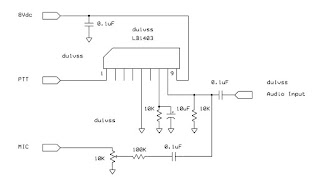The entire circuit is relatively simple and the only drawback is that it needs a high level of audio input coming from the receiver to keep the PTT close all the time during transmission. The protoype board is connected to my Icom IC-2200H as the transmitter and Icom IC-V80 as the receiver. ---73 de du1vss
Saturday, November 3, 2018
Voice Activated Repeater Controller Using LB1403N
The entire circuit is relatively simple and the only drawback is that it needs a high level of audio input coming from the receiver to keep the PTT close all the time during transmission. The protoype board is connected to my Icom IC-2200H as the transmitter and Icom IC-V80 as the receiver. ---73 de du1vss
Saturday, March 31, 2018
Mosfet Replacement in Pallet Amp Trick
I would like to share my trick in replacing the mosfet from pallet amplifier which I learned from my experiences in pallet fabrication and repairs. Most of us would like to unsolder those mosfet legs first one by one and is the most difficult to do since too much heating on those pcb pads would accidentally delaminate the copper from the board.
My shortcut in doing this is to cut the legs of the mosfet using a cutter blade but before doing this please make sure that the mosfet is verified defective!
After freeing the mosfet, now unsolder the remaining mosfet legs from the board using a soldering iron. Cleaned the board, apply fresh thermal paste and mount the new mosfet. 73 de du1vss
Sunday, January 28, 2018
DDS based VFO
Another weekend project is this variable frequency oscillator based from dds chip. I found this project useful in my home brew dsb transceiver and testing several filters and rf amplifiers.
I bought the dds chip from Lazada, the cloned arduino is from Alexan, and the lcd module is from E-Gizmo. The dds is able to generate an rf signal from 1MHz to 30MHz with adjustable tuning steps from 10Hz, 50Hz, 100Hz, 500Hz, 1KHz, 2.5KHz, 5KHz, 10KHz, 100KHz and 1Mhz.
A broadband rf amplifier is also included to boost the amplitude of the dds signal. Around 3V peak to peak was measured at 7Mhz and decrease gradually on higher frequencies.
Credit is given to AD7C in which the schematic and the arduino code was copied. The broadband rf amplifier is not shown however.
A beautiful 7MHz sinusoidal wave can be seen in my Tektonix oscilloscope. One thing I observed however, the 125MHz reference clock is heating specially when the dds module is supplied with 5V but this did not affect the quality of the signal output generated by the module. One option is to use the 3.3V supply found in arduino uno but the signal level from the module is reduced. EMI and other interference could also stop the module from generating rf signal. ---73 de du1vss
Subscribe to:
Posts (Atom)










